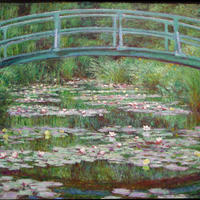More about Orpheus Leading Eurydice from the Underworld
- All
- Info
- Shop

Contributor
Corot’s Orpheus Leading Eurydice from the Underworld makes you wonder if you actually know the myth at all.
The woodland setting jumpstarts the memory for the myth involving the goddess who is so uninterested with the persistent advances of some socially-inept god that she turns herself into a tree. Wait, that’s Apollo and Daphne. So what the heck is this? Greek and Roman myths were confusing enough, Corot. Why’d you have to go and get all fancy on us with this artistic license?
The story of Orpheus and Eurydice is one of those tragic greek myths. Here’s the scene: Orpheus is this half-mortal debonair, a player of the lyre (essentially the ancient Greek guitar). Everyone who heard his song, so the myth goes, could not resist its charm. It is not hard to imagine, then, that when Orpheus came over to woo Eurydice, he came over with a revealing dress to show off his bulging biceps as he strummed along on his lyre. Their romance was brief though, like a Shakespearean sonnet: Eurydice died from a random snake bite. This tormented the songsmith, who decided to walk all the way down to Hades, while playing his lyre (maybe here he sketched the original riffs to Highway to Hell or Hell’s Bells), to demand that his love be returned to him. Pluto, being moved by the songs that Orpheus sings, agrees to give Eurydice back on the one condition that he doesn’t look back at his beloved as they leave the Underworld. Thus begins the end of the myth.
This final scene is the moment Corot depicted. The more you look, you realize how clearly this is a portrait of Orpheus: the lyre, the look of determination forward as he leads someone (and just look at those biceps). You also see that the hazy figures in the background of the woods are all weeping, perhaps the recently deceased grieving their own death. Yet Corot decided to show us the moment before Orpheus looks back, eternally separating the two lovers. Greeks knew how to write a tearjerker.
What’s interesting about this painting is that when it was first premiered at a salon in 1861, Corot had placed a tree between the two lovers, a symbolic reference to their imminent loss of the other (and perhaps the reason why he relocated the setting to a forest in the first place). Sometime after the show, he decided to remove the tree and redesigned the two lovers. The painting was much lauded at the time, and Corot himself was compared to Orpheus as one who exits one world to another as a dreamer amongst serene imagery.
What was lost on a lot of those critics was that Corot was inspired to make the painting after seeing Berlioz’s revival of Gluck’s Orfeo ed Euridice, an opera based on the same myth. The opera was noted at its time for ravishing set designs, which likely influenced Corot’s composition here. Like a good lyre lick, or so I'd imagine, that’s pretty darn cool.
Sources
- Smee, Sebastian. "A 19th-century Painting That Rivals the Mona Lisa." The Washington Post. September 24, 2018. Accessed April 29, 2019. https://www.washingtonpost.com/entertainment/museums/a-19th-century-pai…
- Hamilton, Edith, and Christopher Wormell. Mythology. New York: Back Bay Books/Little, Brown and Company, 2013.
- Tinterow, Gary, Michael Pantazzi, and Vincent Pomarède. Corot:. New York: Metropolitan Museum of Art, 1996.













